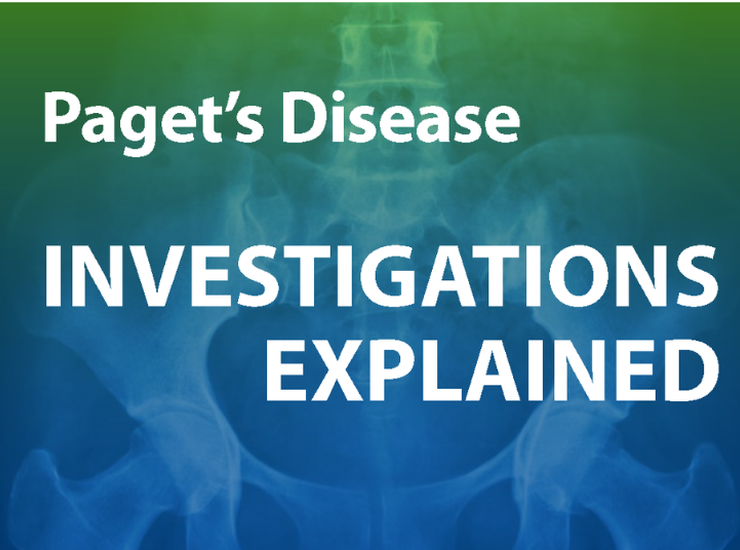Diagnosis
Should I approach my GP if I am concerned about Paget’s disease?
If you are concerned that you may have Paget’s disease, you should see your GP who will assess your symptoms and may carry out initial investigations such as blood tests. You should tell your GP about any history of Paget’s disease in your family. If required, your GP can refer you to a consultant for a full assessment.
Assessment
When Paget’s disease is suspected, it is important that there is a detailed assessment process, ideally carried out by a hospital consultant who understands the condition. The consultant will consider symptoms, enquire about any family history of the condition, and ensure that appropriate investigations are carried out.
Many rheumatologists and endocrinologists have the expertise to treat patients with Paget’s disease and it is likely that most hospitals in the UK have a specialist who can deal with the condition. The website of your local hospital may list your local specialists. In the UK, they are often (not always) found in the rheumatology or endocrinology department. In some areas, there may be a metabolic bone centre or clinic. If there is no specialist locally, then referral to one of the Paget’s Association Centres of Excellence might be beneficial.
Centres of Excellence
The Paget's Association has awarded Centre of Excellence status to several hospital and university departments which demonstrate excellence in both the treatment of Paget’s disease and research into the condition. Details can be found on this website.
Diagnosis and treatment - key facts
- Most people are over 50 when they are diagnosed with Paget’s disease
- The condition may be identified by an x-ray, blood test or radionuclide bone scan
- A radionuclide bone scan is the best way to determine the distribution and extent of Paget’s disease
- Paget’s disease does not always cause any symptoms and not everyone needs treatment, but if there is pain which is thought to be caused by Paget’s disease, treatment with bisphosphonates should normally be given
- A detailed assessment is key, since there are many potential causes of pain in people who have Paget’s disease
- The current first-line treatment for pain caused by Paget’s disease is zoledronic acid, since it is the one most likely to relieve pain from active Paget’s disease, but other bisphosphonates can also be effective
- If pain is present, usually the benefits of treatment outweigh the risk of any potential side effects
Diagnosis
- The majority of people are over fifty when they are diagnosed with Paget’s disease
- The condition may be identified by an x-ray, blood test or bone scan
- In many cases, Paget’s disease is found by chance when tests are carried out for another reason
- It has been estimated that less than 10% of patients with x-ray evidence of Paget’s disease come to medical attention
Blood tests
A common blood test in general practice is to measure liver function. Included in this test is an enzyme called alkaline phosphatase (ALP). This is present in many cells within the body, but particularly in liver and bone cells (osteoblasts). If there is overactivity of the osteoblasts due to Paget’s disease, alkaline phosphatase is released into the bloodstream and can be measured.
When Paget’s disease is active, the ALP level will often, but not always, be raised. A raised ALP can stand out as being the only abnormal result. If there is co-existent liver disease, it may be necessary to perform further blood tests to identify the source of the elevated ALP.
If the total ALP values are normal and clinical suspicion of Paget’s disease is high, then measurement of more specialised tests such as bone alkaline phosphatase (BALP) or N-terminal propeptide of type I procollagen (P1NP) may be required.
X-ray
When an x-ray is taken of a bone affected by Paget’s disease, characteristic features can often be seen. Research has shown that plain x-rays targeted to several sites, the abdomen, skull and facial bones, and both tibiae (shins), are likely to detect 93% of bones affected by Paget’s disease, compared with a single x-ray of the abdomen, which detected less (79%). A single x-ray cannot give information about the many bones which can be affected by Paget’s disease. A radionuclide bone scan is the best way of fully evaluating the extent of Paget’s disease.

This x-ray, of the upper part of the hip, shows a patient with normal bone on one side and bone affected by Paget’s disease on the other (seen on the left side of the picture). The affected bone is enlarged and the pattern of the bone is abnormal. The x-ray also shows a small stress fracture (indicated by the arrow), which reflects the fact the bone is weak and can be a cause of pain.
Bone scan
There are two types of bone scan in common use. Dual-energy x-ray absorptiometry (DEXA) scans, which are used in the diagnosis of osteoporosis, and radionuclide bone scans, used in the diagnosis of other bone conditions.
Radionuclide bone scans also known as scintigrams, isotope bone scans or nuclear medicine bone scans, are the most helpful in Paget’s disease. A scan is recommended to determine which bones have Paget’s disease and how active the disease is. The radionuclide scan involves the use of a small amount of a radioactive tracer, which is injected into a vein in the arm. After some time, the tracer collects in the bones and pictures can be taken by a scanner (gamma camera).
Bone biopsy
A bone biopsy is a procedure in which a small sample of bone is taken and examined under a microscope. This is seldom required but can be useful if there is uncertainty about the diagnosis.
For a more detailed explanation of tests, please see our booklet below.
Investigations Explained

Paget's Disease - Investigations Explained
Investigations that may be carried out in relation to Paget’s disease
PDF 330.7kb
